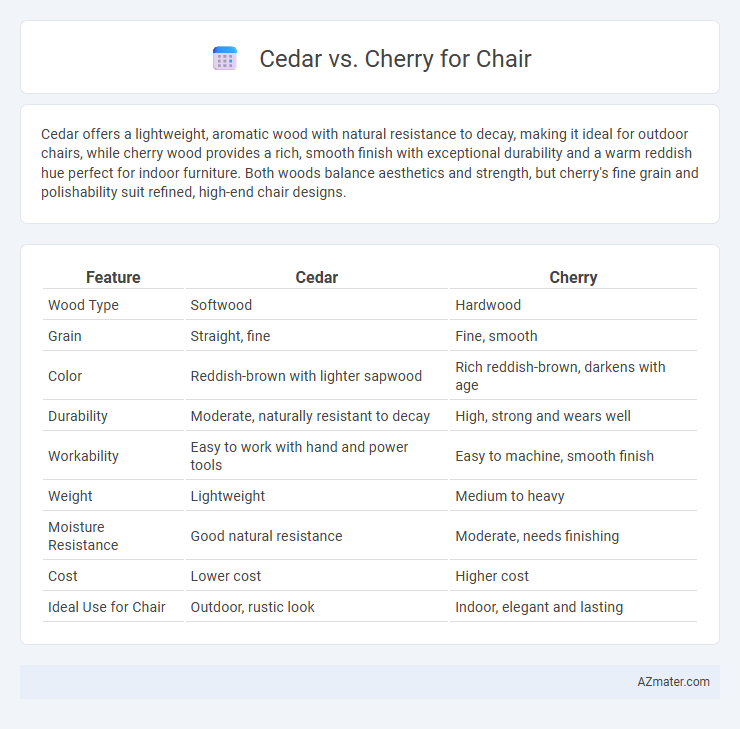Cedar offers a lightweight, aromatic wood with natural resistance to decay, making it ideal for outdoor chairs, while cherry wood provides a rich, smooth finish with exceptional durability and a warm reddish hue perfect for indoor furniture. Both woods balance aesthetics and strength, but cherry's fine grain and polishability suit refined, high-end chair designs.
Table of Comparison
| Feature | Cedar | Cherry |
|---|---|---|
| Wood Type | Softwood | Hardwood |
| Grain | Straight, fine | Fine, smooth |
| Color | Reddish-brown with lighter sapwood | Rich reddish-brown, darkens with age |
| Durability | Moderate, naturally resistant to decay | High, strong and wears well |
| Workability | Easy to work with hand and power tools | Easy to machine, smooth finish |
| Weight | Lightweight | Medium to heavy |
| Moisture Resistance | Good natural resistance | Moderate, needs finishing |
| Cost | Lower cost | Higher cost |
| Ideal Use for Chair | Outdoor, rustic look | Indoor, elegant and lasting |
Introduction to Cedar and Cherry Wood
Cedar wood is renowned for its natural resistance to decay and insect damage, offering lightweight durability and a distinct aromatic scent that repels pests, making it ideal for outdoor and indoor chairs. Cherry wood, prized for its rich reddish-brown color and smooth grain, ages gracefully developing a deep patina, providing strength and elegance in fine furniture craftsmanship. Both woods bring unique aesthetic and functional qualities to chair design, with cedar emphasizing resilience and scent, while cherry highlights beauty and longevity.
Key Characteristics of Cedar
Cedar wood is known for its natural resistance to decay, insects, and moisture, making it an excellent choice for chair construction in both indoor and outdoor settings. Its lightweight yet durable properties, combined with a distinctive aromatic scent, enhance comfort and longevity compared to cherry wood. Cedar's fine grain and warm reddish-brown hues provide a rustic aesthetic that ages gracefully, maintaining structural integrity over time.
Distinctive Features of Cherry Wood
Cherry wood is prized for its rich, warm reddish-brown color that deepens and develops a beautiful patina over time, making each chair uniquely attractive. Its fine, straight grain and smooth texture contribute to an elegant, refined appearance and a comfortable, tactile surface. Additionally, cherry wood offers excellent durability and moderate hardness, ensuring long-lasting chairs that resist dents and wear while aging gracefully.
Durability: Cedar vs Cherry
Cherry wood exhibits superior durability for chairs, offering strong resistance to wear, dents, and impact due to its dense hardwood structure. Cedar, while softer and lighter, is more prone to scratches and dents but excels in natural resistance to moisture and decay, making it ideal for outdoor chair use. For long-lasting indoor chairs, cherry provides greater durability, whereas cedar suits applications requiring weather resistance.
Appearance and Aesthetics Comparison
Cedar chairs exhibit a warm, reddish-brown hue with prominent grain patterns that lend a rustic and natural aesthetic, ideal for cozy, cabin-inspired interiors. Cherry wood chairs develop a rich, deep mahogany patina over time, offering a smooth, elegant finish that suits traditional and sophisticated decor styles. The contrast between cedar's vibrant, textured appearance and cherry's refined, glossy surface allows for versatile design choices depending on desired ambiance and formality.
Comfort and Ergonomics for Chairs
Cherry wood offers a smooth, warm surface that enhances comfort in chair seating by providing gentle support and a slight natural give. Cedar wood, known for its lightweight and aromatic properties, contributes to ergonomic benefits through its natural shock absorption and breathability, reducing fatigue during prolonged use. Both woods support ergonomic design, but cherry's denser structure delivers firmer support, while cedar's cushioning effect promotes relaxation and posture alignment.
Workability and Crafting Ease
Cherry wood offers excellent workability due to its fine grain and smooth texture, making it ideal for crafting detailed chair designs with precision. Cedar is softer and lighter, allowing for easier cutting and shaping, but it may splinter more easily compared to cherry, requiring careful handling during construction. Both woods respond well to sanding and finishing, but cherry's durability and stability make it a preferred choice for long-lasting, finely crafted chairs.
Maintenance and Longevity
Cedar chairs require regular sealing or staining to maintain their resistance to moisture and prevent cracking, while cherry chairs benefit from occasional polishing to preserve their rich color and smooth finish. Cedar is naturally rot-resistant, making it ideal for outdoor furniture with moderate maintenance, whereas cherry wood, being hardwood, offers superior durability and ages beautifully indoors with minimal upkeep. Both woods can last decades, but cherry chairs typically have greater longevity due to their density and ability to withstand indoor environmental changes without warping.
Environmental Impact and Sustainability
Cedar wood offers a lower environmental impact due to its fast growth rate and natural resistance to pests, reducing the need for chemical treatments. Cherry wood, while slower growing, is often sourced from managed forests that promote long-term sustainability and carbon sequestration. Both woods contribute to eco-friendly furniture practices, but cedar's rapid renewability gives it a slight advantage in sustainable chair production.
Best Choice: Cedar or Cherry for Chairs
Cherry wood offers a rich, warm tone and excellent durability, making it a premier choice for chairs that require both elegance and longevity. Cedar, while lighter and naturally resistant to decay and insects, is softer and may dent or scratch more easily, which is less ideal for frequently used chairs. For long-lasting, aesthetically pleasing chairs, cherry wood stands out as the superior option.

Infographic: Cedar vs Cherry for Chair
 azmater.com
azmater.com